Research on the Flow-Induced Stress Characteristics of Head-Cover Bolts of a Pump-Turbine during Turbine Start-Up
Abstract
:1. Introduction
2. Methodology of Flow-Induced Stress Analysis
3. Flow Field Simulation and Flow Characteristics
3.1. The Calculation Model and Boundary Conditions
3.2. Calibration of the Finite Volume Mesh
3.3. Results and Discussions
4. Flow-Induced Stress Analysis
4.1. The Calculation Model and Boundary Conditions
4.2. Mesh Sensitivity Analysis
4.3. Head-Cover Bolts Preloading and Fluid–Structure Coupling
5. Results and Discussions
5.1. Axial Hydraulic Thrust Force of the Head-Cover
5.2. Stress and Deformation Distribution of the Head-Cover
5.3. Stress Distribution of the Stay Ring
5.4. Stress Distribution of the Head-Cover Bolts
6. Conclusions
- The fluid flow and pressure distribution of the pump-turbine flow channel during turbine start-up have been analysed. The head-cover and head-cover bolts are excited by large hydraulic forces, which cause uneven stress distribution of the structures in the circumferential direction.
- As for the stress distribution of the head-cover bolts, the maximum stress occurs in the bolt with the least deformation. Due to the axisymmetric feature of the head-cover, the bolt positions with the maximum stress and with the maximum deformation differ by approximately 90 degrees in the circumferential direction.
- The maximum von Mises stress of the head-cover during turbine start-up is located in the connecting surface of the head-cover flange and a head-cover bolt. The maximum stress of the head-cover is around 249 MPa, which is below the yield stress 265 MPa of the head-cover material.
- The maximum von Mises stress of the stay ring during turbine start-up is in the fillet of the stay vane. The maximum stress of the stay ring is about 222 MPa, which is below the yield stress of 830 MPa of the stay ring material.
- The maximum von Mises stress of the head-cover bolts due to pretension force is located in the middle of each bolt. The maximum stress of the head-cover bolts is about 430 MPa, which is below the yield stress of 960 MPa of the bolt material.
- The maximum von Mises stress of the head-cover bolts during turbine start-up appears in the fillet of the bolts closed to the head-cover outer flange. The maximum stress of the head-cover bolts is about 377 MPa, which is below the yield stress of 960 MPa of the bolt material.
- During turbine start-up, the maximum stress of the head-cover bolts and the head-cover follow the same trend. At a certain time, the maximum stress of the head-cover bolts is always higher than the stress of the head-cover. Additionally, the maximum stress of the guide vane is less than the one of the head-cover bolts and the head-cover.
- It can be seen that the design of stationary structures and head-cover bolts are safe during turbine start-up which is a very challenging operation condition for the PT unit. The design, simulation methods, and conclusions in this investigation can be used as a good reference for evaluating the flow-induced stress characteristics of head-cover bolts of similar hydraulic pump-turbine units.
Author Contributions
Funding
Institutional Review Board Statement
Informed Consent Statement
Data Availability Statement
Acknowledgments
Conflicts of Interest
Abbreviations
| CFD | computational fluid dynamics |
| FEM | finite element method |
| FSC | fluid–structure coupling |
| FVM | finite volume method |
| PSPS | pumped-storage power station |
| PT | pump-turbine |
References
- Luna-Ramírez, A.; Campos-Amezcua, A.; Dorantes-Gómez, O.; Mazur-Czerwiec, Z.; Muñoz-Quezada, R. Failure Analysis of Runner Blades in a Francis Hydraulic Turbine—Case Study. Eng. Fail. Anal. 2016, 59, 314–325. [Google Scholar] [CrossRef]
- Peltier, R.; Boyko, A.; Popov, S.; Krajisnik, N. Investigating the Sayano-Shushenskaya Hydro Power Plant Disaster. Power 2010, 154, 48. [Google Scholar]
- Zhao, Q.; Chai, J.; Ma, C.; Ding, J.; Li, B. Causes of Header Bolt Fracture of a Pumped Storage Power Station. J. Yangtze River Sci. Res. Inst. 2019, 36, 134–138. [Google Scholar]
- Ling, L.; Rong, W. Failure Analysis on Fracture of Worm Gear Connecting Bolts. Eng. Fail. Anal. 2014, 36, 439–446. [Google Scholar] [CrossRef]
- Liu, D.; Shang, X. Failure Investigation of the Wind Turbine Blade Root Bolt. J. Fail. Anal. Prev. 2013, 13, 333–339. [Google Scholar] [CrossRef]
- Curtis, L.R. Metallurgical Failure Analysis of Fasteners in an Impeller Assembly. J. Fail. Anal. Prev. 2006, 6, 17–22. [Google Scholar] [CrossRef]
- Casanova, F.; Mantilla, C. Fatigue Failure of the Bolts Connecting a Francis Turbine with the Shaft. Eng. Fail. Anal. 2018, 90, 1–13. [Google Scholar] [CrossRef]
- Grimsmo, E.L.; Aalberg, A.; Langseth, M.; Clausen, A.H. Failure Modes of Bolt and Nut Assemblies under Tensile Loading. J. Constr. Steel Res. 2016, 126, 15–25. [Google Scholar] [CrossRef]
- Deng, X.; Li, H.; Huang, S.; Liu, H. Fatigue Life Research on the Connection Bolts of head-cover of Pump-Storage Plant. In Proceedings of the 2019 Annual Academic Conference of China Hydropower Engineering Society Power Grid Peak Shaving and Pumped Storage Professional Committee, Beijing, China, 1 September 2019; pp. 156–161. [Google Scholar]
- Huang, Y.; Guan, Z.; Li, H.; Yang, X.; Li, Z.; Sun, Y. Effects of Chamfering, Cold Expansion, Bolt Clamping, and Their Combinations on Fatigue Life of Aluminum–Lithium Alloy Single Plate. Adv. Mech. Eng. 2018, 10, 1687814017750681. [Google Scholar] [CrossRef] [Green Version]
- Shahani, A.R.; Shakeri, I. Experimental Evaluation of the Effect of Preload on the Fatigue Life of Bolts. Int. J. Steel Struct. 2015, 15, 693–701. [Google Scholar] [CrossRef]
- Luo, Y.; Chen, F.; Chen, L.; Wang, Z.; Yu, J.; Zhu, X.; Zhao, Z.; Ren, S.; Li, J.; Lu, X. Study on Stresses of head-cover Bolts in a pump-turbine Based on FSI. In IOP Conference Series: Earth and Environmental Science; IOP Publishing: Lausanne, Switzerland, 21 March 2021; Volume 804, p. 042062. [Google Scholar]
- Luo, Y.; Chen, F.; Chen, L.; Wang, Z.; Yu, J.; Luo, C.; Zhao, Z.; Ren, S.; Li, J.; Deng, D. Stresses and Relative Stiffness of the head-cover Bolts in a pump-turbine. In IOP Conference Series: Materials Science and Engineering; IOP Publishing: Stuttgart, Germany, 9 October 2019; Volume 493, p. 012113. [Google Scholar]
- Chen, F.; Chen, L.; Wang, Z.; Yu, J.; Luo, C.; Zhao, Z.; Ren, S.; Li, J.; Deng, D. Computation of Static Stresses of the head-cover Bolts in a pump-turbine. In IOP Conference Series: Materials Science and Engineering; IOP Publishing: Stuttgart, Germany, 9 October 2019; Volume 493, p. 012143. [Google Scholar]
- Brekke, H. Performance and Safety of Hydraulic Turbines. In IOP Conference Series: Earth and Environmental Science; IOP Publishing: Timisoara, Romania, 20 September 2010; Volume 12, p. 012061. [Google Scholar]
- Chen, L.; Li, H.; Yu, J.; Luo, Y.; Wang, Z.; Zhu, X.; Zhao, Z.; Lu, X. Stress Analysis of Screw Connection of Key Structural Components in pump-turbine. In IOP Conference Series: Earth and Environmental Science; IOP Publishing: Lausanne, Switzerland, 21 March 2021; Volume 804, p. 032037. [Google Scholar]
- Gagnon, M.; Tahan, A.; Bocher, P.; Thibault, D. Impact of startup scheme on Francis runner life expectancy. In IOP Conference Series: Earth and Environmental Science; IOP Publishing: Timisoara, Romania, 20 September 2010; Volume 12. [Google Scholar] [CrossRef]
- Gagnon, M.; Nicolle, J.; Morissette, J.; Lawrence, M. A look at Francis runner blades response during transients. In IOP Conference Series: Earth and Environmental Science; IOP Publishing: Grenoble, France, 4 July 2016; Volume 49, p. 052005. [Google Scholar] [CrossRef] [Green Version]
- Seidel, U.; Mende, C.; Hübner, B.; Weber, W.; Otto, A. Dynamic loads in Francis runners and their impact on fatigue life. In IOP Conference Series: Earth and Environmental Science; IOP Publishing: Montreal, Canada, 22 September 2014; Volume 22, p. 032054. [Google Scholar] [CrossRef] [Green Version]
- Huang, X.; Chamberland-Lauzon, J.; Oram, C.; Klopfer, A.; Ruchonnet, N. Fatigue analyses of the prototype Francis runners based on site measurements and simulations. In IOP Conference Series: Earth and Environmental Science; IOP Publishing: Montreal, QC, Canada, 22 September 2014; Volume 22, p. 012014. [Google Scholar] [CrossRef] [Green Version]
- Liang, Q.; Lais, S.; Gentner, C.; Braun, O. Efficient runner safety assessment during early design phase and root cause analysis. In Proceedings of the 26th IAHR Symp. on Hydraulic Machinery and Systems, Beijing, China, 19 August 2012. [Google Scholar]
- Lais, S.; Liang, Q.; Henggeler, U.; Weiss, T.; Escaler, X.; Egusquiza, E. Dynamic Analysis of Francis Runners-Experiment and Numerical Simulation. Int. J. Fluid Mach. Syst. 2009, 2, 303–314. [Google Scholar] [CrossRef] [Green Version]
- Xie, J.; Huang, B.; Fu, L. Reinforcement and resonance control of head cover of Francis turbine by finite element analysis and modal testing. In IOP Conference Series: Earth and Environmental Science; IOP Publishing: Bristol, UK, 3 July 2020; Volume 560, p. 012051. [Google Scholar] [CrossRef]
- Jia, Y.; Li, F.; Wei, X.; Li, X.; Li, Z. A method for analysis of head cover deformation and vibration amplitude in Francis hydro-turbine system by combination of CFD and FEA. J. Mech. Sci. Technol. 2017, 31, 4255–4266. [Google Scholar] [CrossRef]
- Zhang, Y.; Chen, T.; Li, J.; Yu, J. Experimental study of load variations on pressure pulsations in a prototype reversible pump-turbine in generating mode. Fluids Eng. 2017, 139, 074501. [Google Scholar] [CrossRef]
- Wang, W.; Wang, X.; Wang, Z.; Ni, M.; Yang, C. Analysis of Internal Flow Characteristics of a start-up pump-turbine at the Lowest Head under No-Load Conditions. J. Mar. Sci. Eng. 2021, 9, 1360. [Google Scholar] [CrossRef]
- Mao, Z.; Tao, R.; Chen, F.; Wang, Z. Investigation of the Starting-Up Axial Hydraulic Force and Structure Characteristics of pump-turbine in Pump Mode. Mar. Sci. Eng. 2021, 9, 158. [Google Scholar] [CrossRef]
- Egusquiza, E.; Valero, M.; Presas, A.; Huang, X.; Guardo, A.; Seidel, U. Analysis of the dynamic response of pump-turbine impellers. Influ. Rotor. Mech. Syst. Signal Process. 2016, 68–69, 330–341. [Google Scholar] [CrossRef]
- He, L.; Wang, Z.; Kurosawa, S.; Nakahara, Y. Resonance investigation of pump-turbine during startup process. In IOP Conference Series: Earth and Environmental Science; IOP Publishing: Montreal, QC, Canada, 2014; Volume 22, p. 32024. [Google Scholar]
- Kolsek, T.; Duhovnik, J.; Bergant, A. Simulation of unsteady flow and runner rotation during shut-down of an axial water turbine. J. Hydraul. Res. Jan. 2006, 44, 129–137. [Google Scholar] [CrossRef]
- Ciocan, G.D.; Iliescu, M.S.; Vu, T.C.; Nennemann, B.; Avellan, F. Experimental Study and Numerical Simulation of the FLINDT Draft Tube Rotating Vortex. J. Fluids Eng. 2006, 129, 146–158. [Google Scholar] [CrossRef]
- Huang, X.; Oram, C.; Sick, M. Static and dynamic stress analyses of the prototype high head Francis runner based on site measurement. In IOP Conference Series: Earth and Environmental Science; IOP Publishing: Montreal, QC, Canada, 2014; Volume 2, p. 032052. [Google Scholar]
- Goyal, R.; Cervantes, M.; Gandhi, B. Characteristics of Synchronous and Asynchronous modes of fluctuations in Francis turbine draft tube during load variation. Int. J. Fluid Mach. Syst. 2017, 10, 164–175. [Google Scholar] [CrossRef]
- Fu, X.; Li, D.; Wang, H.; Zhang, G.; Li, Z.; Wei, X. Dynamic instability of a pump-turbine in load rejection transient process. Sci. China (Technol. Sci.) 2018, 61, 1765–1775. [Google Scholar] [CrossRef]
- Avdyushenko, A.; Chernyi, S.; Chirkov, D. Numerical algorithm for modelling three-dimensional flows of an incompressible fluid using moving grids. Comput. Technol. 2012, 17, 3–25. [Google Scholar]
- Widmer, C.; Staubli, T.; Ledergerber, N. Unstable Characteristics and Rotating Stall in Turbine Brake Operation of Pump-Turbines. J. Fluids Eng. 2011, 133, 041101. [Google Scholar] [CrossRef]
- Nicolle, J.; Giroux, A.; Morissette, J. CFD configurations for hydraulic turbine startup. In IOP Conference Series: Earth and Environmental Science; IOP Publishing: Montreal, QC, Canada, 2014; Volume 22, p. 032021. [Google Scholar]
- Bi, H.; Chen, F.; Wang, C.; Wang, Z.; Fan, H.; Luo, Y. Analysis of dynamic performance in a pump-turbine during the successive load rejection. In IOP Conference Series: Earth and Environmental Science; IOP Publishing: Lausanne, Switzerland, 2021; Volume 774, p. 012152. [Google Scholar]
- Li, X.; Mao, Z.; Lin, W.; Bi, H.; Tao, R.; Wang, Z. Prediction and Analysis of the Axial Force of Pump-Turbine during Load-Rejection Process. In IOP Conference Series: Earth and Environmental Science; IOP Publishing: Lausanne, Switzerland, 2021; Volume 440, p. 052081. [Google Scholar]
- Münch, C.; Ausoni, P.; Braun, O.; Farhat, M.; Avellan, F. Fluid–structure coupling for an oscillating hydrofoil. J. Fluids Struct. 2010, 26, 1018–1033. [Google Scholar] [CrossRef]
- Benra, F.; Dohmen, H. Comparison of Pump Impeller Orbit Curves Obtained by Measurement and FSI Simulation. Asme Press. Vessel. Pip. Conf. 2007, 42827, 41–48. [Google Scholar]
- Kato, C.; Yoshimura, S.; Yamade, Y.; Jiang, Y.Y.; Wang, H.; Imai, R.; Katsura, H.; Yoshida, T.; Takano, Y. Prediction of the Noise From a Multi-Stage Centrifugal Pump. In Proceedings of the Fluids Engineering Division Summer Meeting, Houston, TX, USA, 19 June 2005. [Google Scholar]
- Jiang, Y.; Yoshimura, S.; Imai, R.; Katsura, H.; Yoshida, T.; Kato, C. Quantitative evaluation of flow-induced structural vibration and noise in turbomachinery by full-scale weakly coupled simulation. J. Fluids Struct. 2007, 23, 531–544. [Google Scholar] [CrossRef]
- Menter, F.R. Two-equation eddy-viscosity turbulence models for engineering applications. AIAA 1994, 32, 1598–1605. [Google Scholar] [CrossRef] [Green Version]
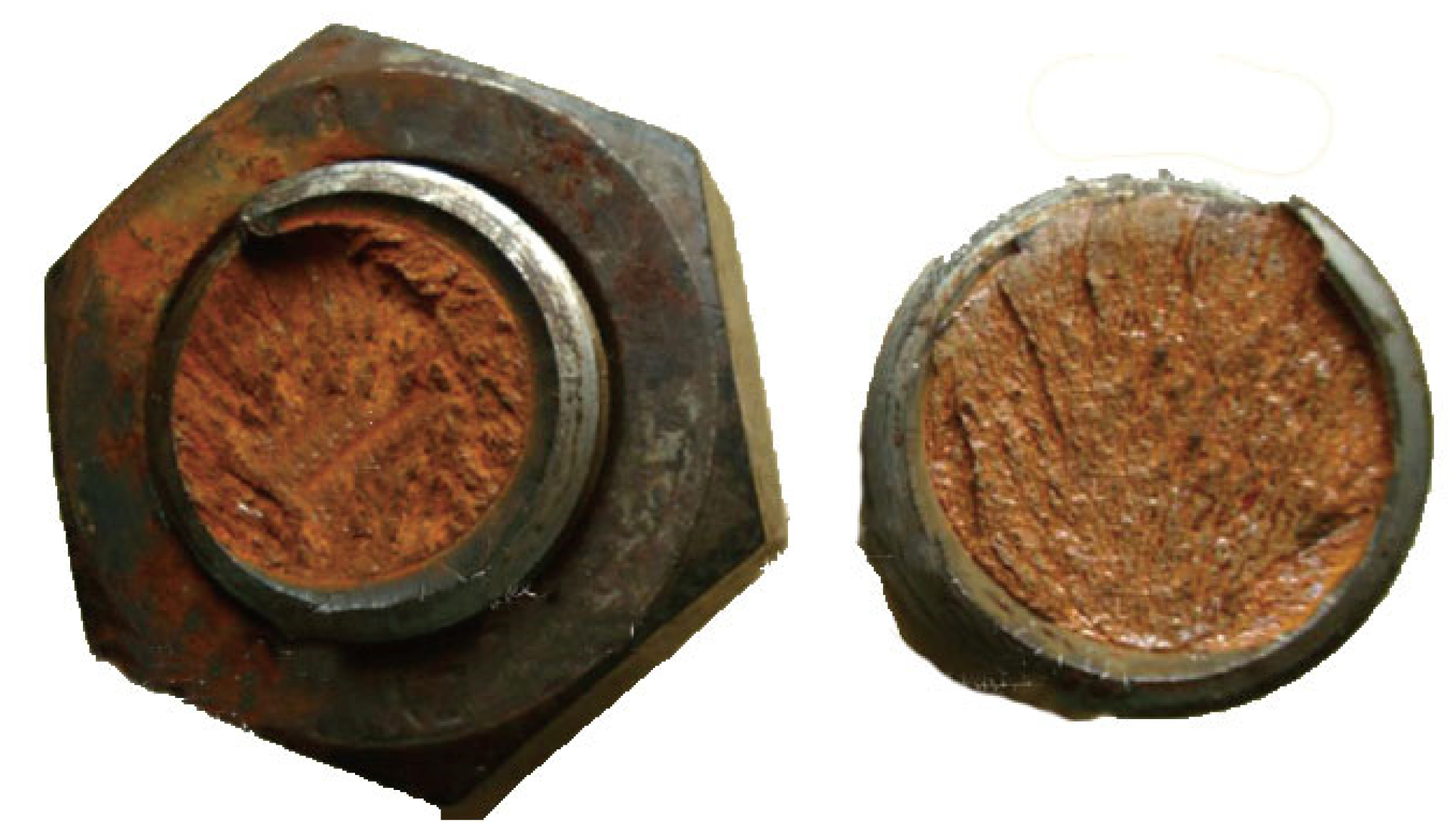
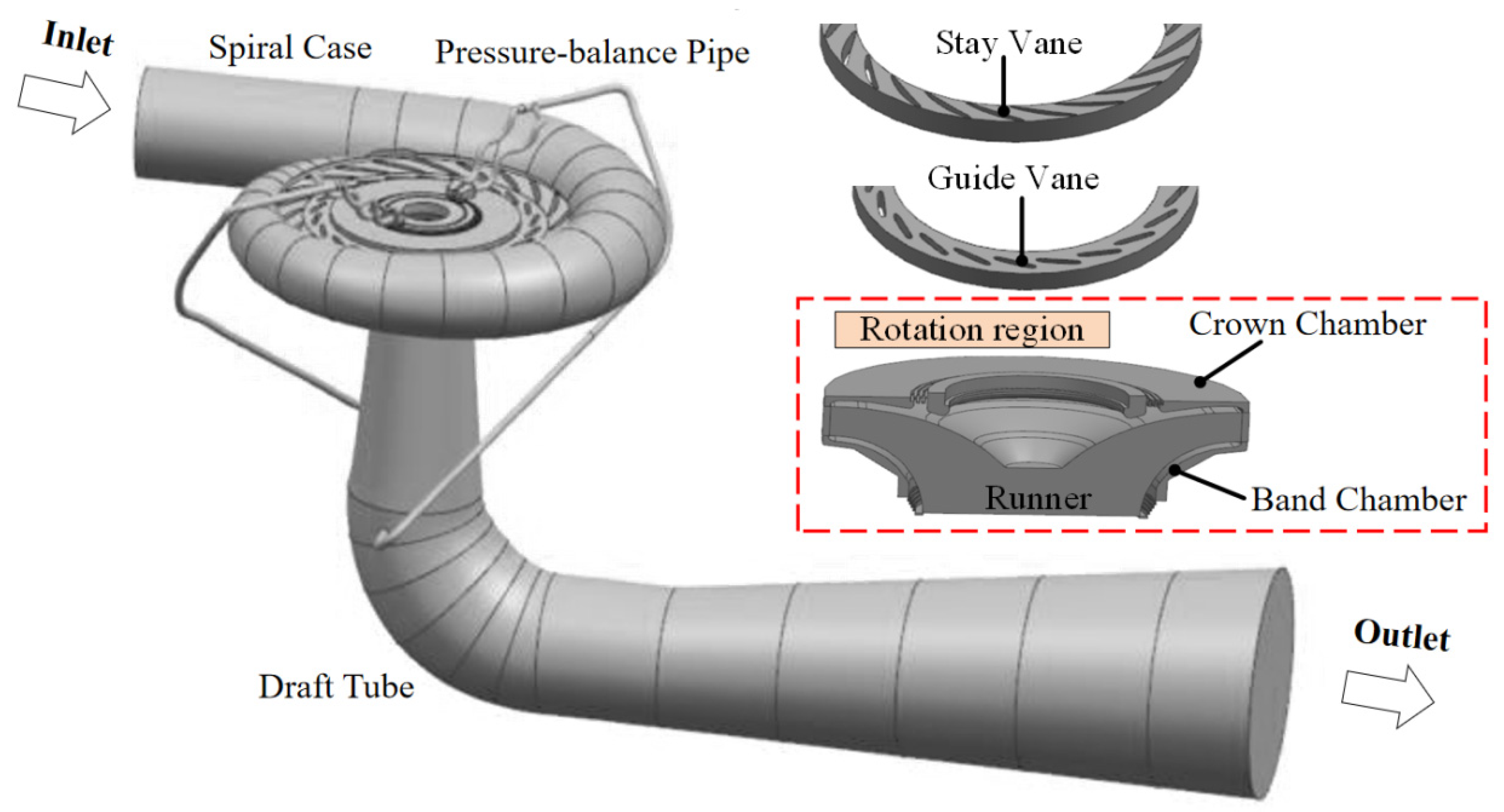
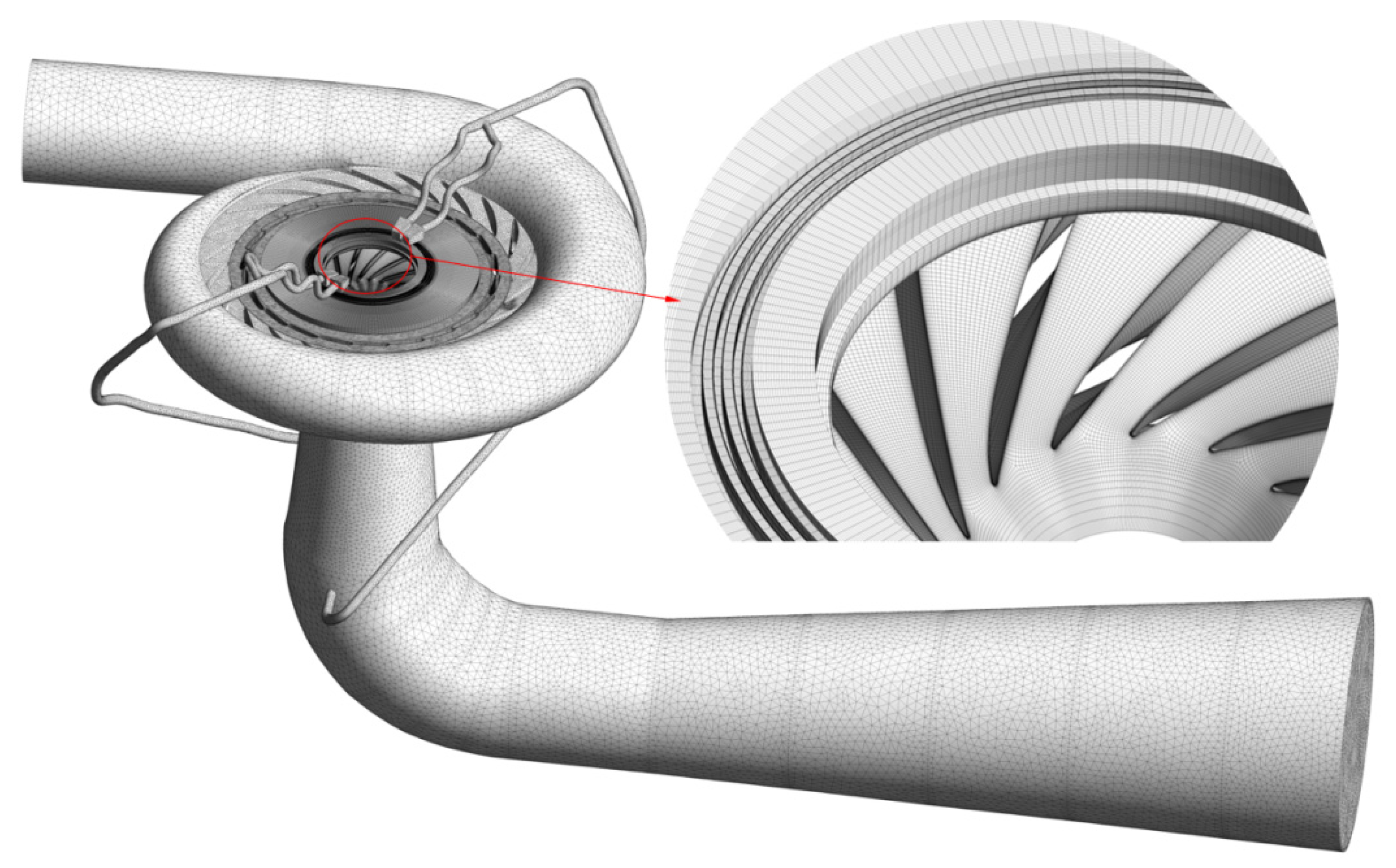



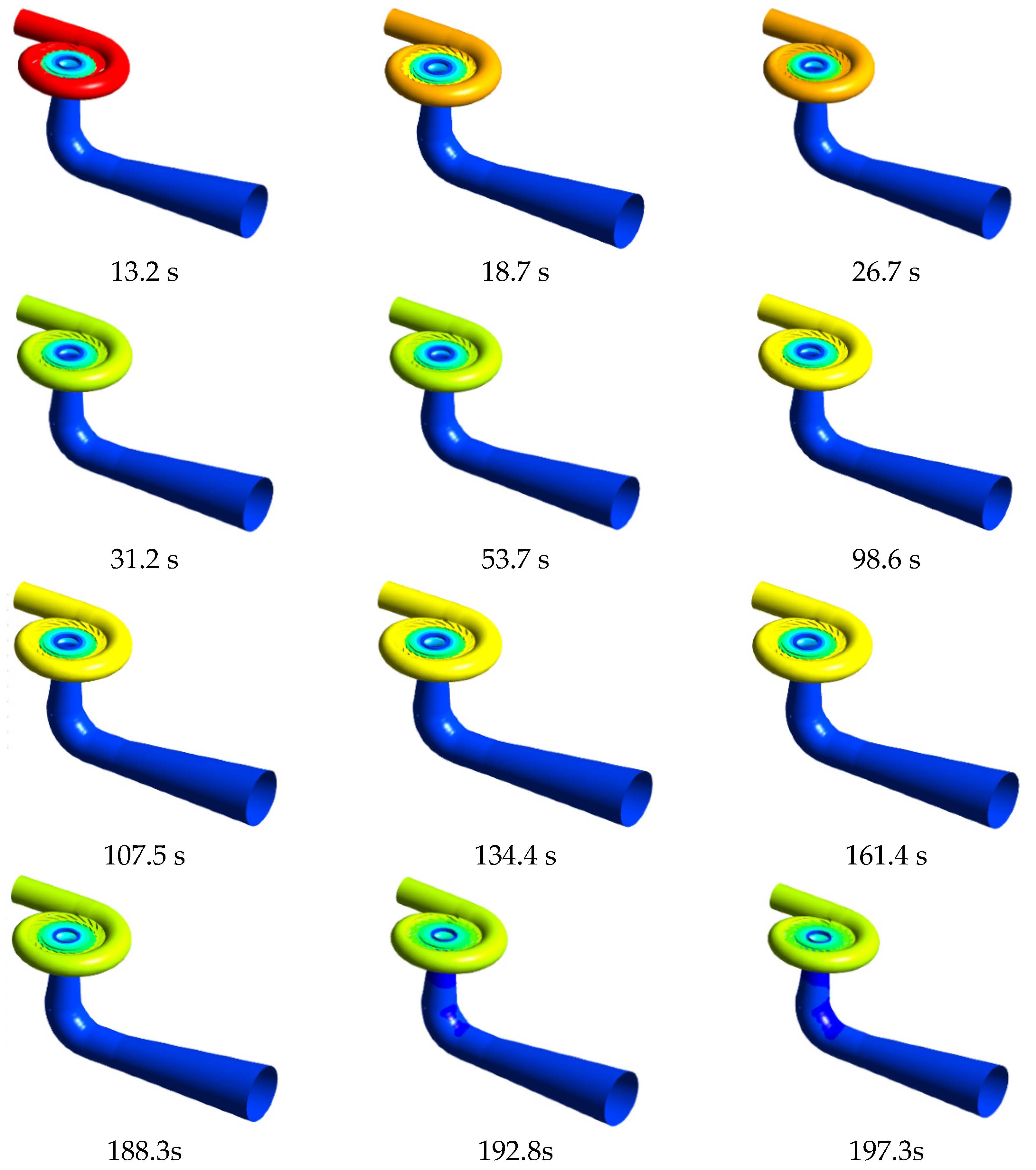


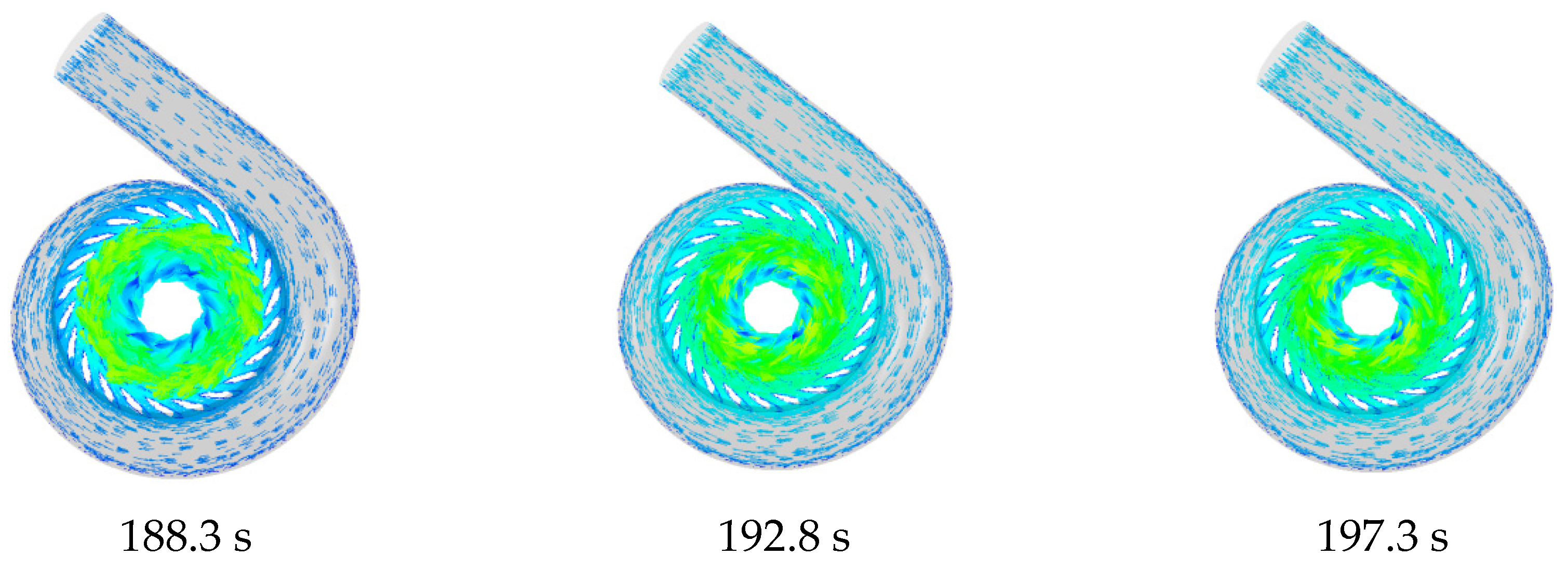
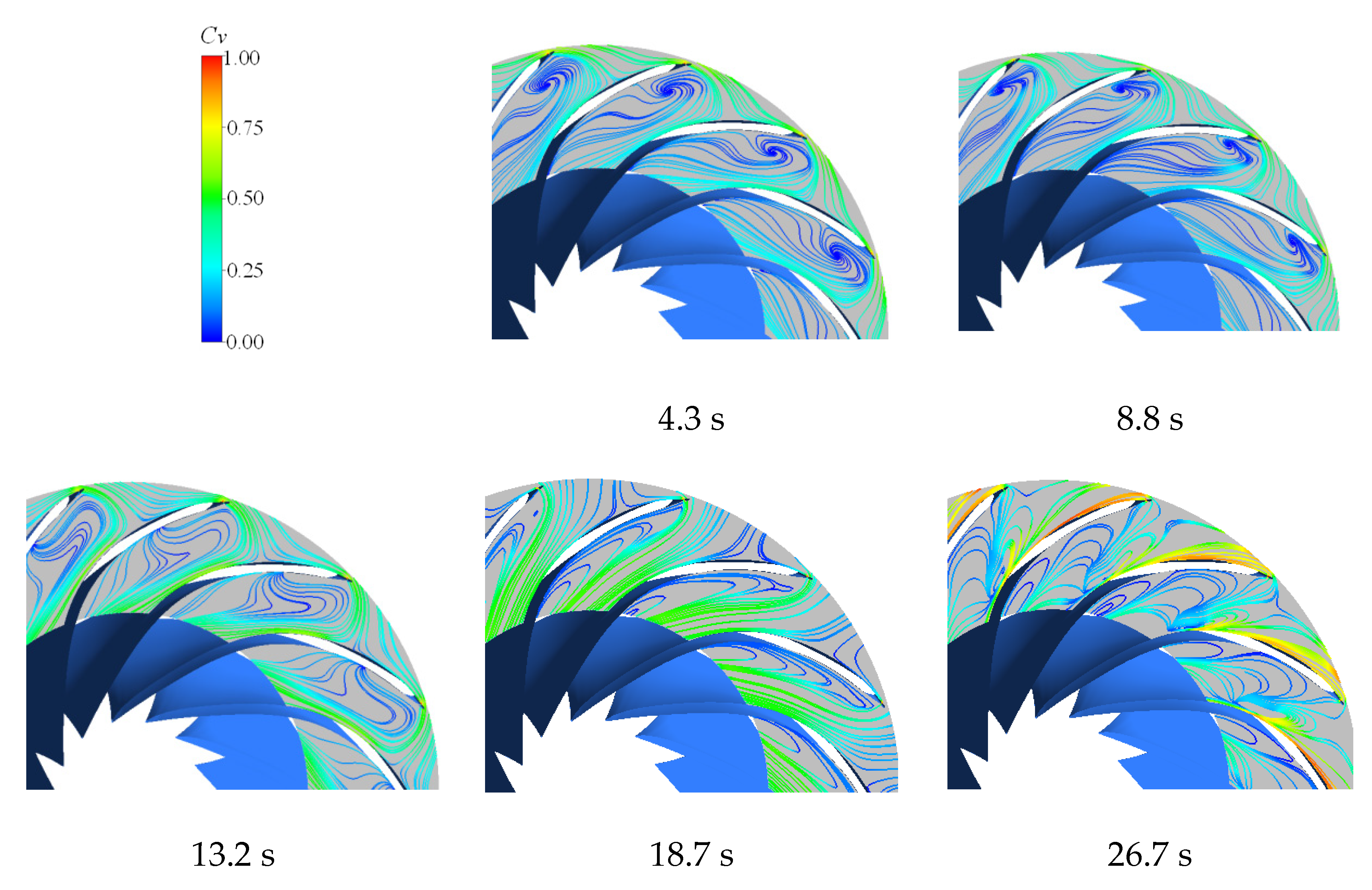
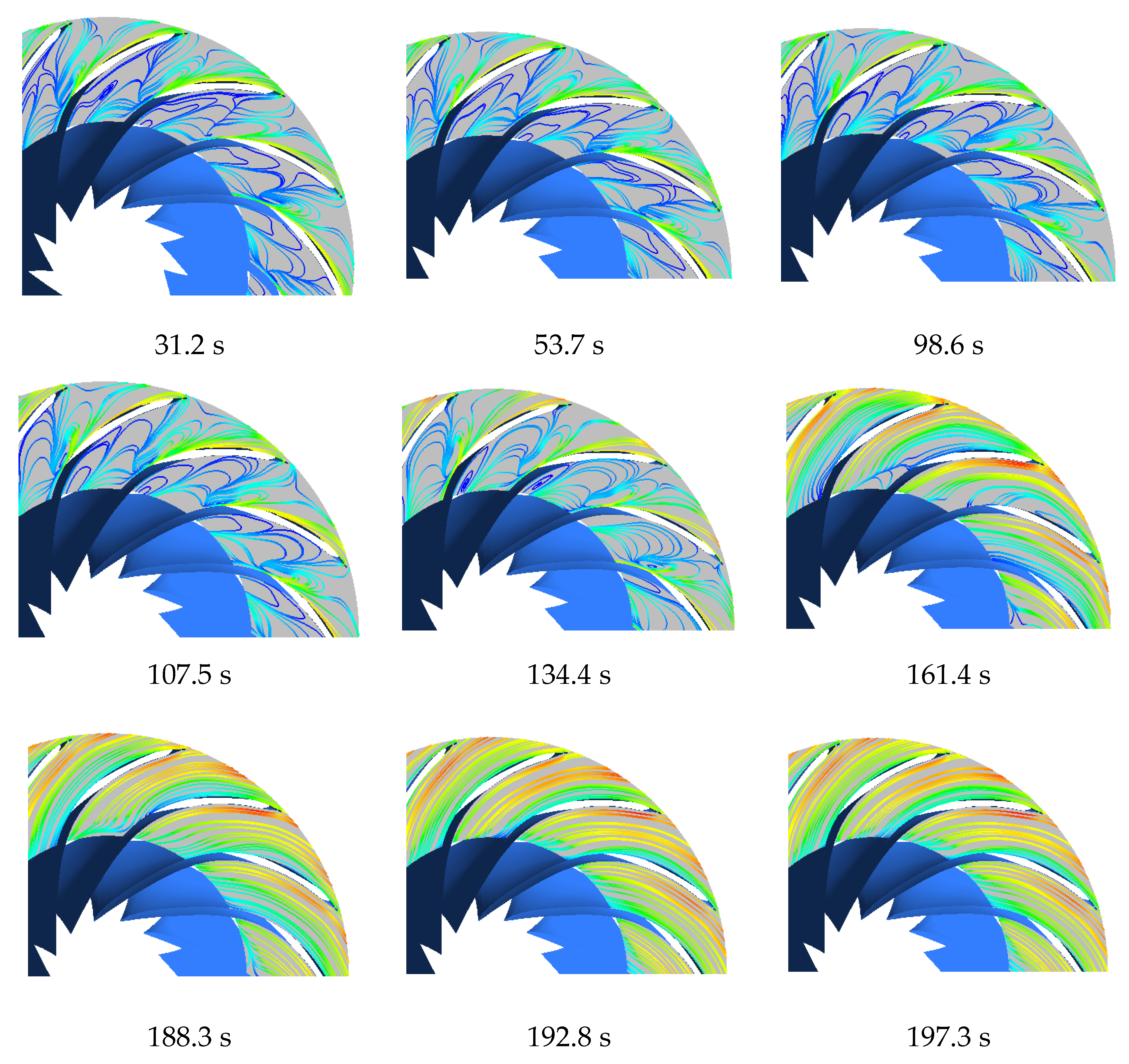
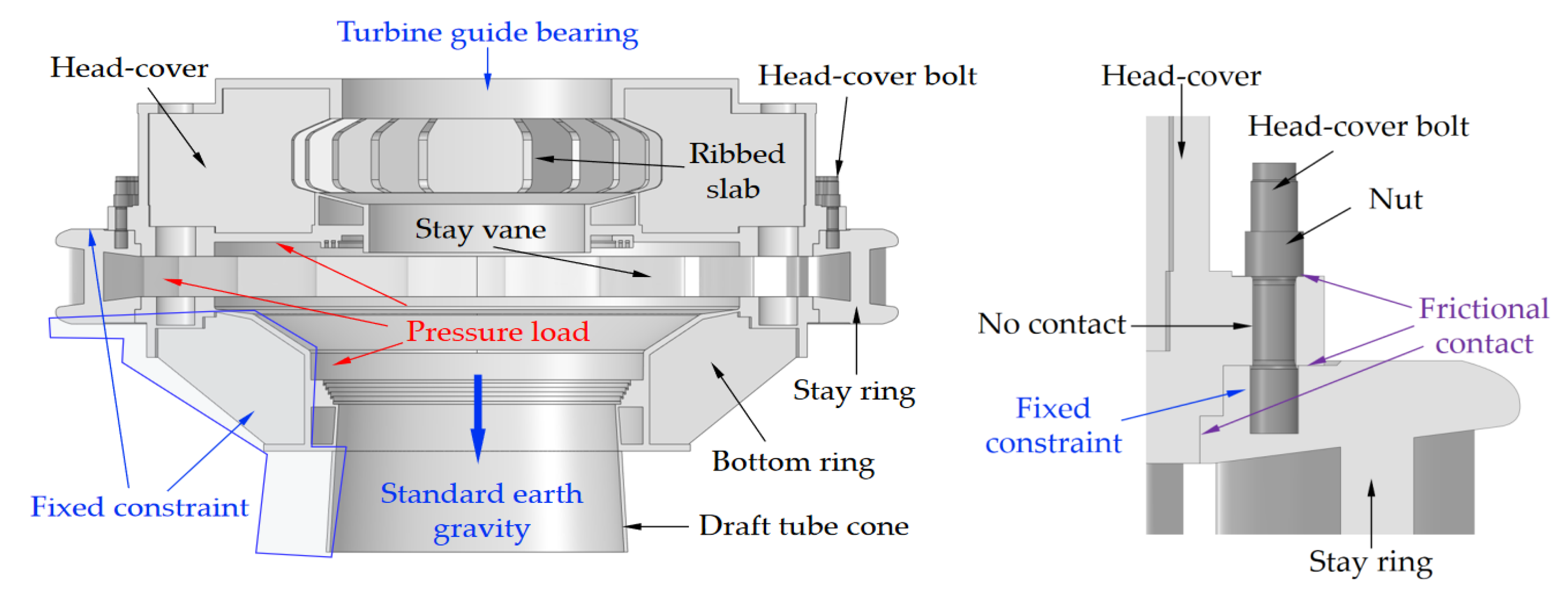
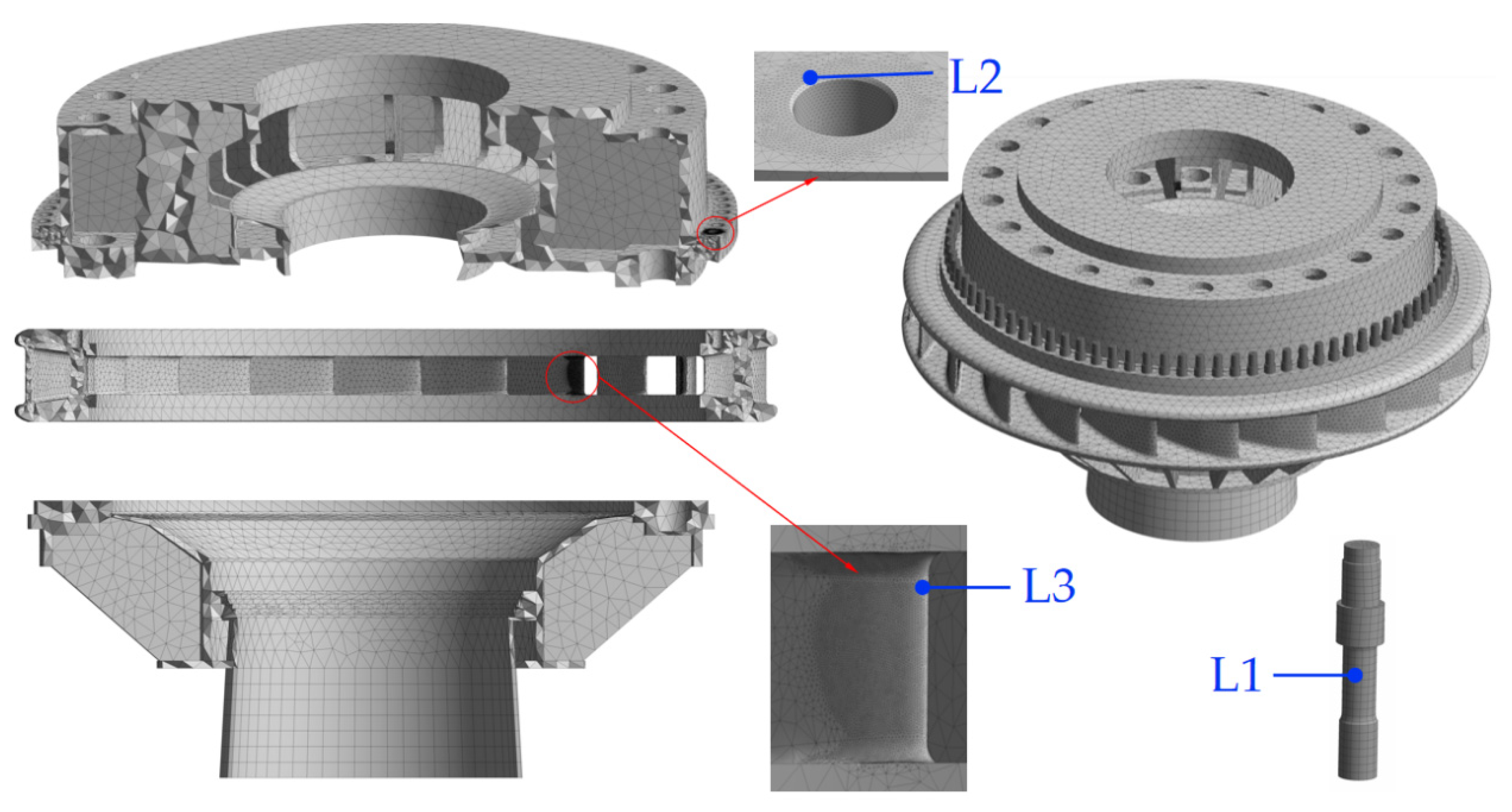

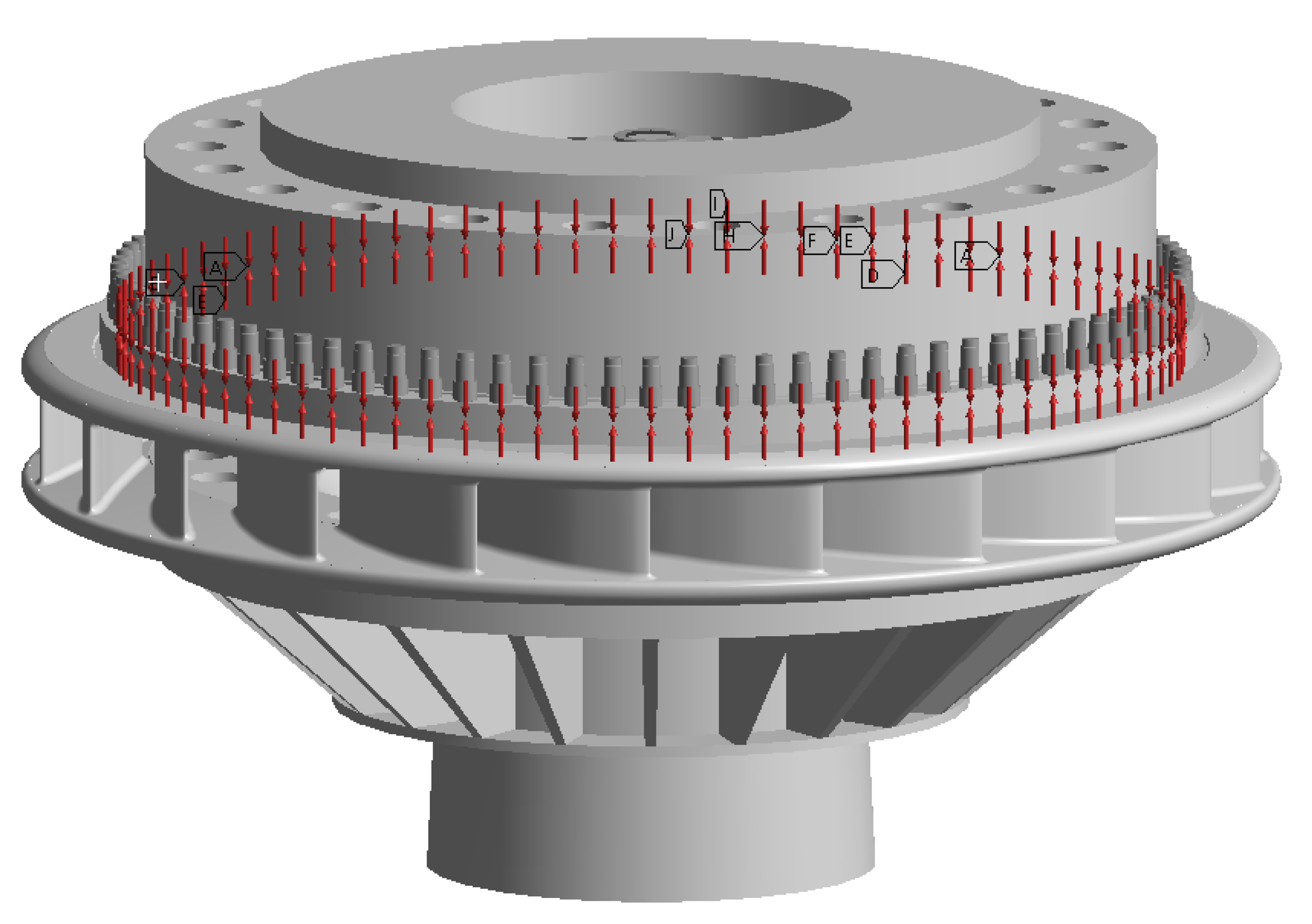
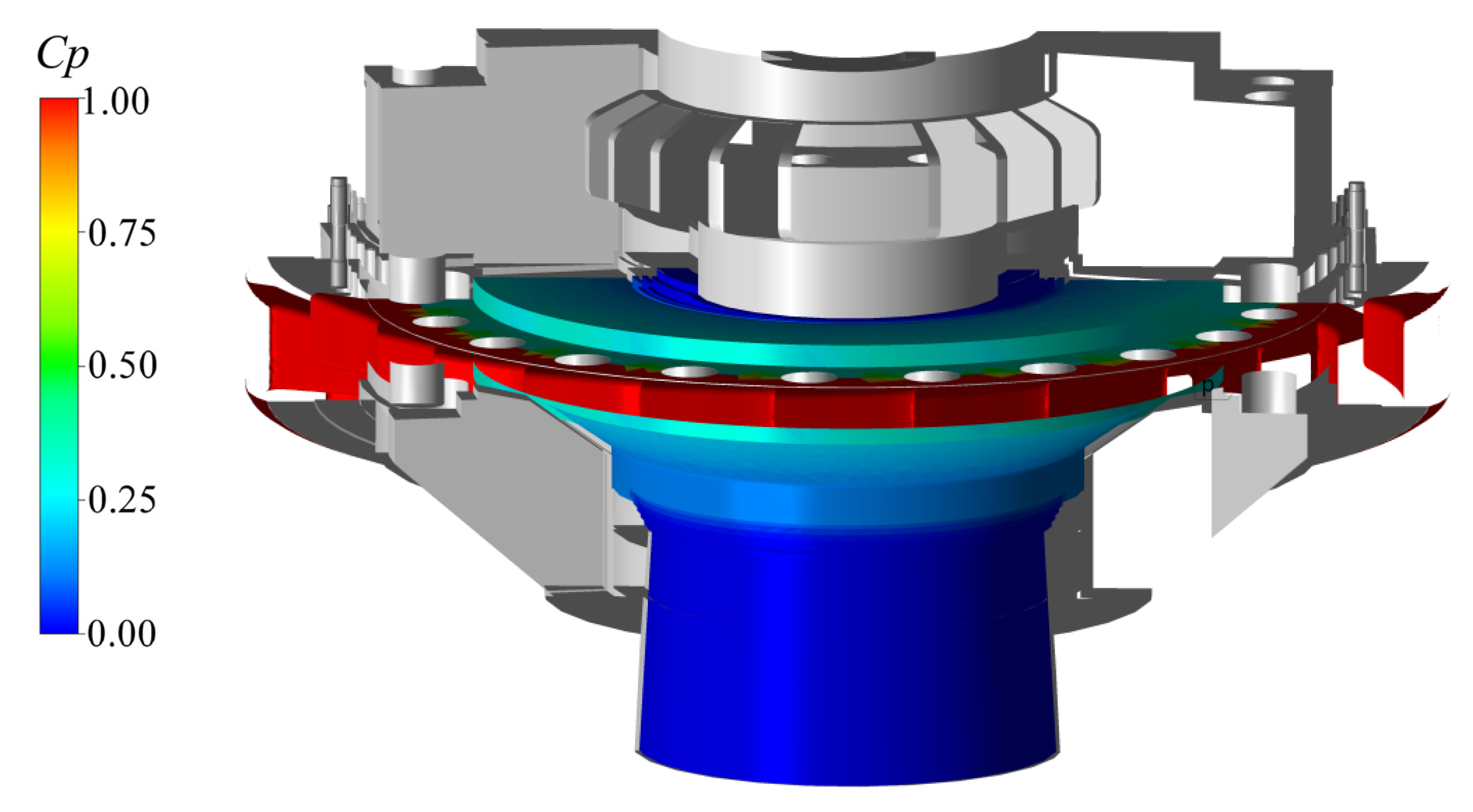

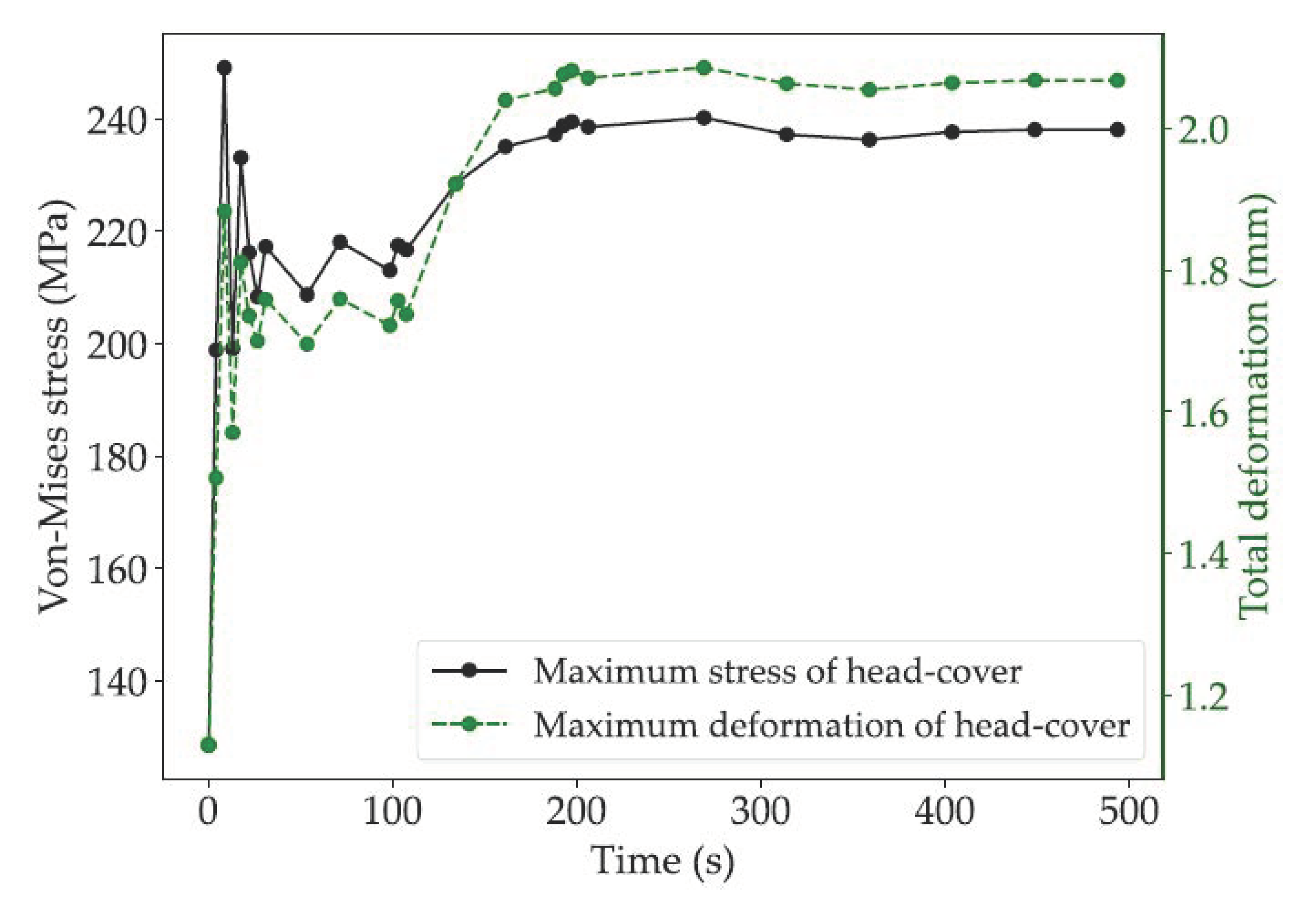




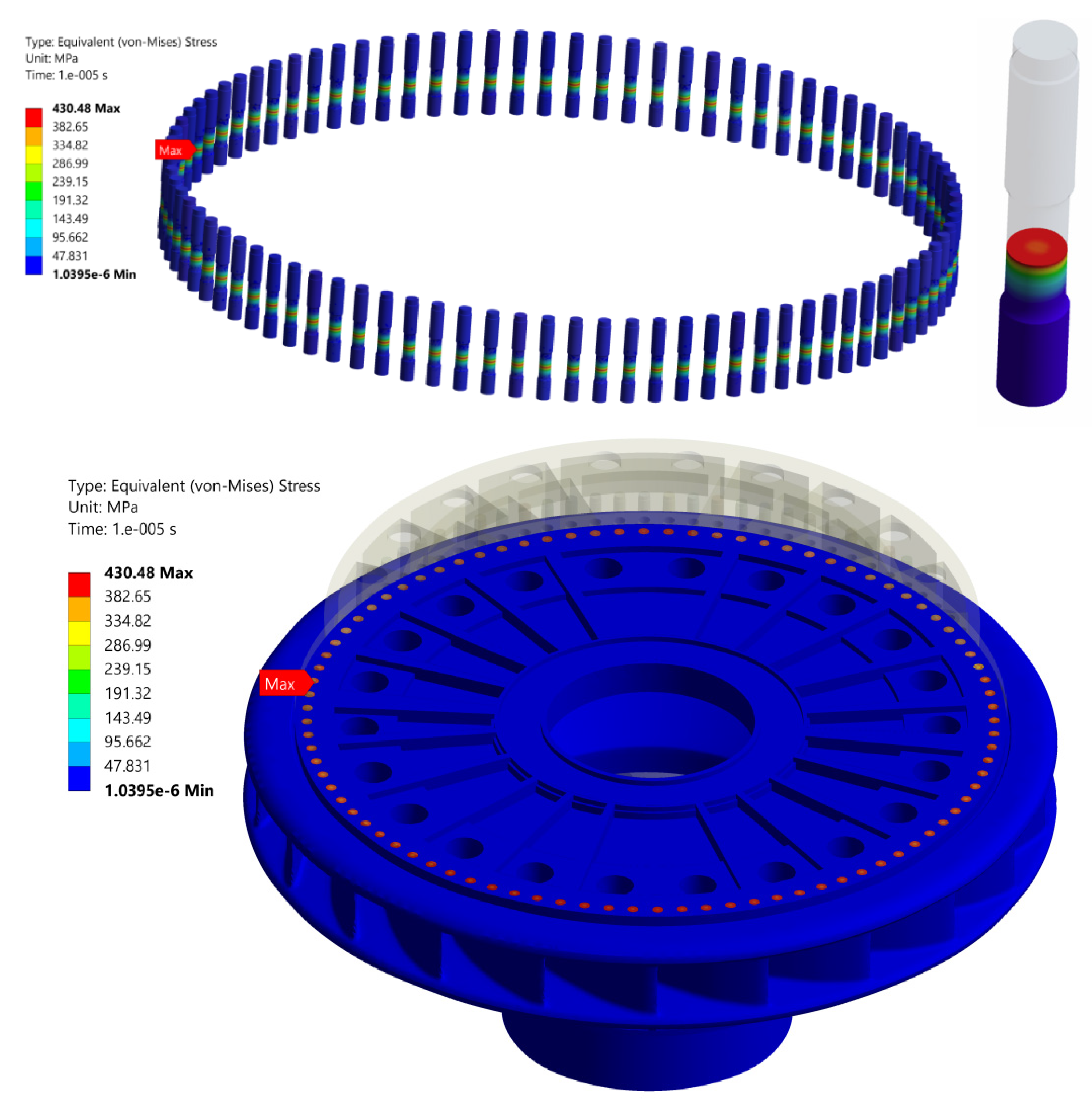
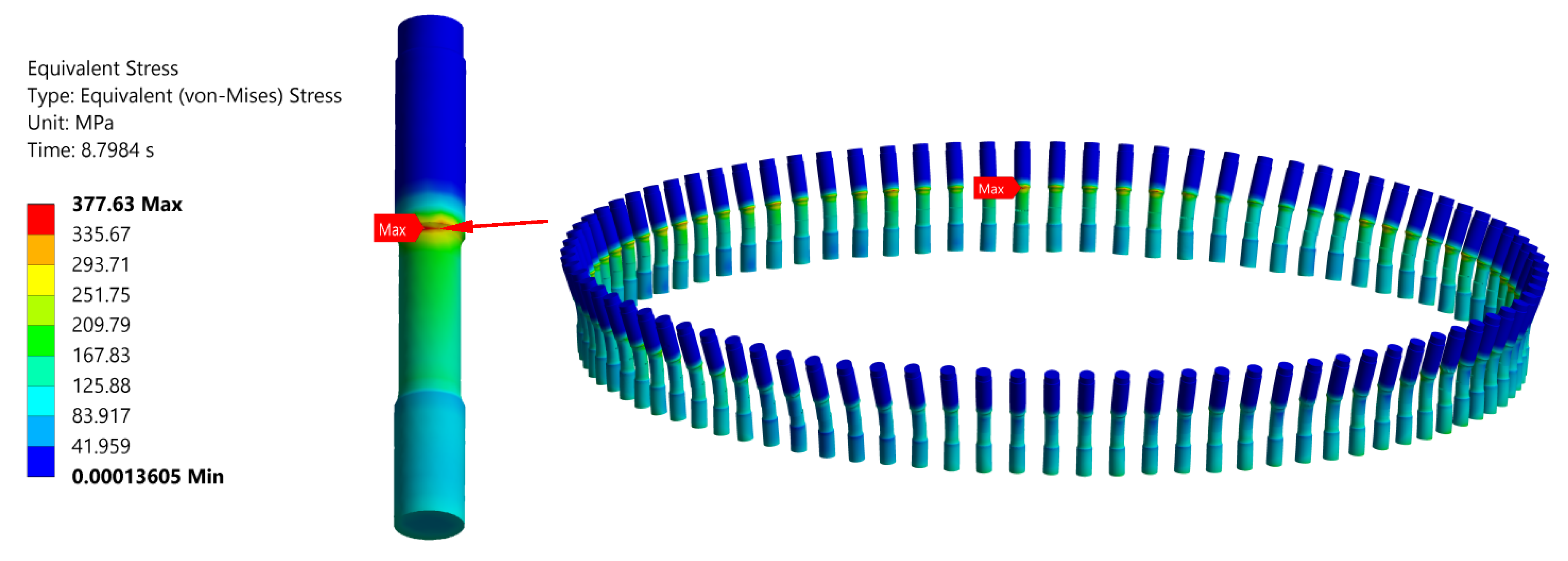


| Spiral Case | Stay Vane | Guide Vane | Runner | Crown Chamber | Band Chamber | Pressure-Balance Pipe | Draft Tube | Total | |
|---|---|---|---|---|---|---|---|---|---|
| Element number | 57,796 | 103,493 | 593,210 | 3,417,050 | 531,518 | 422,700 | 53,113 | 86,041 | 5,264,921 |
| Head-Cover Bolt | Head-Cover | Stay Ring | |
|---|---|---|---|
| Material | 34CrNi3Mo | Q345C | Cr13Ni5Mo |
| Density (kg·m−3) | 7850 | 7850 | 7850 |
| Elastic modulus (MPa) | 2.1 × 105 | 2.1 × 105 | 2.1 × 105 |
| Poisson’s ratio | 0.3 | 0.3 | 0.3 |
| Tightening force (kN) | 4196 | - | - |
| Yield stress (MPa) | 960 | 265 | 830 |
| Ultimate stress (MPa) | 1100 | 450 | 980 |
Publisher’s Note: MDPI stays neutral with regard to jurisdictional claims in published maps and institutional affiliations. |
© 2022 by the authors. Licensee MDPI, Basel, Switzerland. This article is an open access article distributed under the terms and conditions of the Creative Commons Attribution (CC BY) license (https://creativecommons.org/licenses/by/4.0/).
Share and Cite
Wang, Z.; Yang, J.; Wang, W.; Qu, J.; Huang, X.; Zhao, W. Research on the Flow-Induced Stress Characteristics of Head-Cover Bolts of a Pump-Turbine during Turbine Start-Up. Energies 2022, 15, 1832. https://doi.org/10.3390/en15051832
Wang Z, Yang J, Wang W, Qu J, Huang X, Zhao W. Research on the Flow-Induced Stress Characteristics of Head-Cover Bolts of a Pump-Turbine during Turbine Start-Up. Energies. 2022; 15(5):1832. https://doi.org/10.3390/en15051832
Chicago/Turabian StyleWang, Zhengwei, Juwei Yang, Wei Wang, Jie Qu, Xingxing Huang, and Weiqiang Zhao. 2022. "Research on the Flow-Induced Stress Characteristics of Head-Cover Bolts of a Pump-Turbine during Turbine Start-Up" Energies 15, no. 5: 1832. https://doi.org/10.3390/en15051832
APA StyleWang, Z., Yang, J., Wang, W., Qu, J., Huang, X., & Zhao, W. (2022). Research on the Flow-Induced Stress Characteristics of Head-Cover Bolts of a Pump-Turbine during Turbine Start-Up. Energies, 15(5), 1832. https://doi.org/10.3390/en15051832










